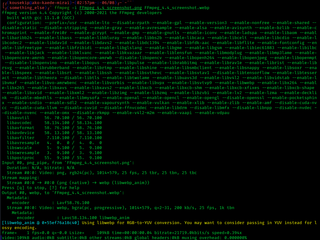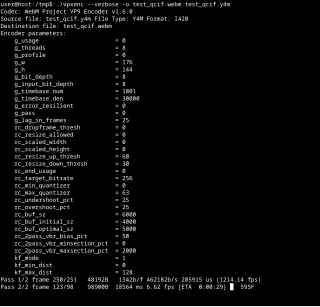Related Research Articles

A video codec is software or hardware that compresses and decompresses digital video. In the context of video compression, codec is a portmanteau of encoder and decoder, while a device that only compresses is typically called an encoder, and one that only decompresses is a decoder.

FFmpeg is a free and open-source software project consisting of a suite of libraries and programs for handling video, audio, and other multimedia files and streams. At its core is the command-line ffmpeg tool itself, designed for processing of video and audio files. It is widely used for format transcoding, basic editing, video scaling, video post-production effects and standards compliance.

VP8 is an open and royalty-free video compression format released by On2 Technologies in 2008.
SILK is an audio compression format and audio codec developed by Skype Limited, now a Microsoft subsidiary. It was developed for use in Skype, as a replacement for the SVOPC codec. Since licensing out, it has also been used by others. It has been extended to the Internet standard Opus codec.
High Efficiency Video Coding (HEVC), also known as H.265 and MPEG-H Part 2, is a video compression standard designed as part of the MPEG-H project as a successor to the widely used Advanced Video Coding. In comparison to AVC, HEVC offers from 25% to 50% better data compression at the same level of video quality, or substantially improved video quality at the same bit rate. It supports resolutions up to 8192×4320, including 8K UHD, and unlike the primarily 8-bit AVC, HEVC's higher fidelity Main 10 profile has been incorporated into nearly all supporting hardware.
The HTML5 specification introduced the video element for the purpose of playing videos, partially replacing the object element. HTML5 video is intended by its creators to become the new standard way to show video on the web, instead of the previous de facto standard of using the proprietary Adobe Flash plugin, though early adoption was hampered by lack of agreement as to which video coding formats and audio coding formats should be supported in web browsers. As of 2020, HTML5 video is the only widely supported video playback technology in modern browsers, with the Flash plugin being phased out.

libvpx is a free software video codec library from Google and the Alliance for Open Media (AOMedia). It serves as the reference software implementation for the VP8 and VP9 video coding formats, and for AV1 a special fork named libaom that was stripped of backwards compatibility.

x265 is an encoder for creating digital video streams in the High Efficiency Video Coding (HEVC/H.265) video compression format developed by the Joint Collaborative Team on Video Coding (JCT-VC). It is available as a command-line app or a software library, under the terms of GNU General Public License (GPL) version 2 or later; however, customers may request a commercial license.
A video coding format is a content representation format for storage or transmission of digital video content. It typically uses a standardized video compression algorithm, most commonly based on discrete cosine transform (DCT) coding and motion compensation. A specific software, firmware, or hardware implementation capable of compression or decompression to/from a specific video coding format is called a video codec.

VP9 is an open and royalty-free video coding format developed by Google.
Daala is a video coding format under development by the Xiph.Org Foundation under the lead of Timothy B. Terriberry mainly sponsored by the Mozilla Corporation. Like Theora and Opus, Daala is available free of any royalties and its reference implementation is being developed as free and open-source software. The name is taken from the fictional character of Admiral Natasi Daala from the Star Wars universe.
Nvidia NVENC is a feature in Nvidia graphics cards that performs video encoding, offloading this compute-intensive task from the CPU to a dedicated part of the GPU. It was introduced with the Kepler-based GeForce 600 series in March 2012.
NETVC was the name given to a planned royalty-free video codec that was intended to be developed in the former Internet Video Codec working group of the IETF. It was intended to provide a royalty-free alternative to industry standards such as H.264/AVC and HEVC that have required licensing payments for many uses. The chairs of the working group were Matthew Miller of Outer Planes and Mo Zanaty of Cisco Systems. A list of criteria to be met by the new video standard was produced in April 2020 as Informational RFC 8761, and the working group was closed.
The Alliance for Open Media (AOMedia) is a non-profit industry consortium headquartered in Wakefield, Massachusetts and formed to develop open, royalty-free technology for multimedia delivery. It uses the ideas and principles of open web standard development to create video standards that can serve as alternatives to the hitherto dominant standards of the Moving Picture Experts Group (MPEG).
High Efficiency Image File Format (HEIF) is a container format for storing individual digital images and image sequences. The standard covers multimedia files that can also include other media streams, such as timed text, audio and video.
AOMedia Video 1 (AV1) is an open, royalty-free video coding format initially designed for video transmissions over the Internet. It was developed as a successor to VP9 by the Alliance for Open Media (AOMedia), a consortium founded in 2015 that includes semiconductor firms, video on demand providers, video content producers, software development companies and web browser vendors. The AV1 bitstream specification includes a reference video codec. In 2018, Facebook conducted testing that approximated real-world conditions, and the AV1 reference encoder achieved 34%, 46.2% and 50.3% higher data compression than libvpx-vp9, x264 High profile, and x264 Main profile respectively.
Internet Video Coding is a video coding standard. IVC was created by MPEG, and was intended to be a royalty-free video coding standard for use on the Internet, as an alternative to non-free formats such as AVC and HEVC. As such, IVC was designed to only use coding techniques which were not covered by royalty-requiring patents.
Versatile Video Coding (VVC), also known as H.266, ISO/IEC 23090-3, and MPEG-I Part 3, is a video compression standard finalized on 6 July 2020, by the Joint Video Experts Team (JVET), a joint video expert team of the VCEG working group of ITU-T Study Group 16 and the MPEG working group of ISO/IEC JTC 1/SC 29. It is the successor to High Efficiency Video Coding. It was developed with two primary goals – improved compression performance and support for a very broad range of applications.
References
- ↑ A. Fuldseth; G. Bjontegaard; S. Midtskogen; T. Davies; M. Zanaty (2016-03-18). "Thor Video Codec". IETF . Retrieved 2016-06-14.
- ↑ "NETVC IETF 93". Internet Engineering Task Force. Retrieved 2015-08-11.
- ↑ "Thor: High Efficiency, Moderate Complexity Video Codec using only RF IPR" (PDF). Internet Engineering Task Force. Retrieved 2015-08-11.
- ↑ NETVC Hackathon Results IETF 93 (Prague) (PDF)
- ↑ "New open standard for Ultra High Definition video will enable enhanced video playback". Alliance for Open Media. 2015-09-01. Archived from the original on 2015-09-03. Retrieved 2015-09-01.
- ↑ Stephen Shankland (2015-09-01). "Tech giants join forces to hasten high-quality online video". CNET . Retrieved 2015-09-01.
- ↑ Zimmerman, Steven (15 May 2017). "Google's Royalty-Free Answer to HEVC: A Look at AV1 and the Future of Video Codecs". XDA Developers. Archived from the original on 14 June 2017. Retrieved 10 June 2017.
- ↑ IETF101-NETVC-20180319-1550. IETF - Internet Engineering Task Force. 19 March 2018. Retrieved 23 May 2018– via YouTube.
It's certainly possible to get real-time encoding with Thor, that we know, but for AV1, it's not proven yet.
- ↑ "Thor update and AV1 comparisons". IETF. Retrieved 23 May 2018.